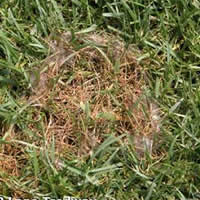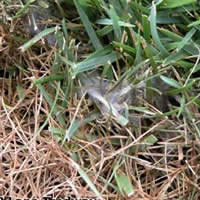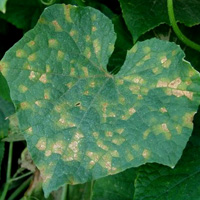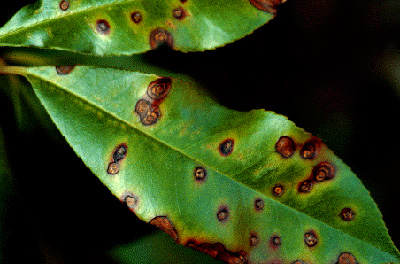Grass and Plant Diseases
|
|||||||||||||||||||
Downy Mildew can usually be found on the underside of the leaves and not just on the top of the leaves. Downy mildew begins with yellow leaf lesions that appear as indefinite yellow or brownish areas on the upper leaf surface that represents a spore producing fungus. The fungus grows within pods covering the seed with a white crust of spores. The texture of downy mildew is cottony or fuzzy. The disease is disfiguring and growth may be stunted. The disease is usually more severe in moist shaded areas. |
|||||||||||||||||||
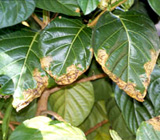

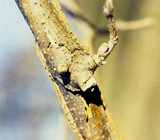
|
|||||||||||||||||||
Anthracnose is a group of diseases found on many deciduous and evergreen trees and shrubs; some trees such as sycamore, ash, and evergreen elms can be noticeably blighted. Often called leaf, shoot, or twig blight, anthracnose results from infection by any of several different fungi, depending on the tree attacked. Anthracnose symptoms vary with the plant host, weather, and time of year infection occurs. Small tan, brown, black, or tarlike spots appear on infected leaves of hosts such as elm or oak. Dead leaf areas may be more irregular on other hosts such as ash. Sycamore anthracnose lesions typically develop along the major leaf veins. If leaves are very young when infected, they may become curled and distorted with only a portion of each leaf dying. Generally, mature leaves are resistant to infection, but when conditions are favorable, they may become spotted with lesions. Heavily infected leaves fall prematurely throughout the growing season, and sometimes trees are completely defoliated. Early leaf drop is usually followed by production of more leaves. Twigs and branches also may be attacked and killed, resulting in a tree with crooked branches. |
|||||||||||||||||||
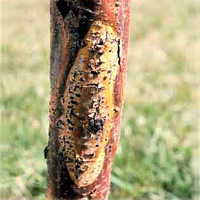
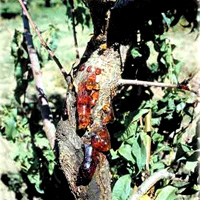
|
|||||||||||||||||||
Canker Disease Aspen, cottonwood, mountain ash, willow and elm trees with environmental or weather-related stress are often more susceptible to canker diseases. These diseases also strike thin-barked trees that are susceptible to sun burns. A canker is an inverted blister on the bark of the tree which, during some time of the year, may ooze sap. A canker forms on branches or trunks of trees. Fungi, very small organisms that produce spores and mold-like material, cause most canker diseases. Leaves of a tree affected by these fungi begin to turn yellow and may drop to the ground. Some limbs may not develop new leaves in the spring. In severe cases, trees may die if canker disease isn't |
|||||||||||||||||||
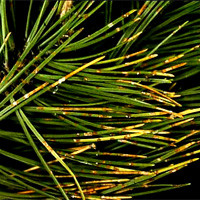
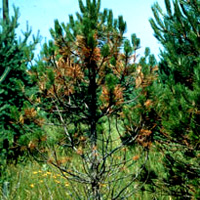
|
|||||||||||||||||||
Dothistroma Needle Blight is a common fungal disease that causes browning of needles of Austrian, ponderosa, and mugo pines. Affected needles have reddish brown spots or bands. The needle tips beyond the bands dry out and turn brown a couple weeks after the bands appear, while the bases remain green. Diseased needles may drop prematurely, several months after they are infected. Typically, the most severely affected branches are towards the bottom of the tree. |
|||||||||||||||||||
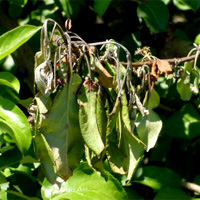
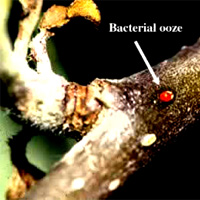
|
|||||||||||||||||||
Fire Blight is the enemy of rosebushes and apple and pear trees. It is caused by a bacteria (erwinia amylovora) which attacks starting generally from the blossoms or flowers and moving up to the twigs and then the branches. Fire blight gets its name from the burnt appearance of affected blossoms and twigs. Flowers turn brown and wilt; twigs shrivel and blacken, the ends often curling. In more advanced cases of bacterial infestation, cankers, discolored oozing patches, form on branches. The translucent amber or reddish ooze contains masses of bacteria. |
|||||||||||||||||||
|
|
|||||||||||||||||||
Leaf Spots are caused by a variety of fungi and some bacteria on many trees. An especially harmful version of this disease is called anthracnose which attacks many tree species including dogwood and sycamore. Positive identification usually requires laboratory diagnosis. A leaf spot disease creates spots on foliage. The spots will vary in size and color depending on the plant, the organism involved and the stage of development. Spots are most often brownish, but may be tan or black. Concentric rings or a dark margin around the spot may be present. Over time the spots may combine to enlarge and form blotches. Spots or blotches that are angular and located around the veins are generally referred to as anthracnose. Leaves may yellow and drop prematurely. |
|||||||||||||||||||

Cedar Apple Rust This disease is very common on juniper or cedar trees in Oklahoma. The most striking feature of this disease is the gall that appears on the cedar in the spring. Long, orange, gelatinous tendrils or horns develop from these galls and homeowners can easily recognize these structures and know that this disease is active. |
|||||||||||||||||||
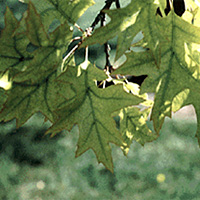

|
|||||||||||||||||||
Iron Chlorosis - Affected leaves turn a yellowish color while the leaf veins remain a dark green. Iron chlorosis is caused by the plant not being able to obtain the iron it needs. Iron is needed for the production of chlorophyll. Therefore, a lack of iron results in a loss of the green color in the leaves. Symptoms may appear over the entire tree, on one side only, or be limited to individual branches. In severe cases, leaf color may change from yellow to white to brown. If uncorrected, twigs and eventually branches may die leading to the death of the tree. Most Susceptible Trees: Pin oak, silver maple, baldcypress, crabapple and sweet gum. Can also affect white pine, elm, London planetree, cottonwood, walnut, sugar maple, Eastern redcedar, Bradford pear and willow. Click here for a free estimate request form! |
|||||||||||||||||||

